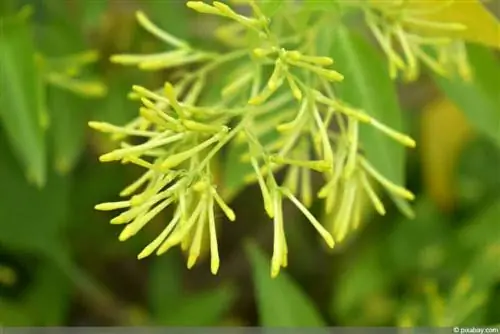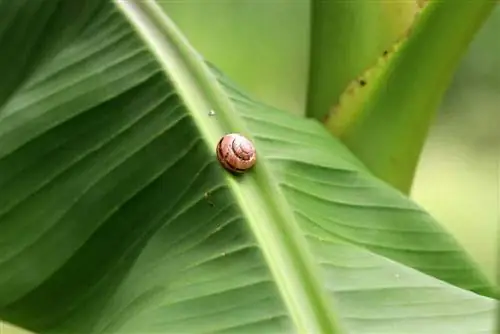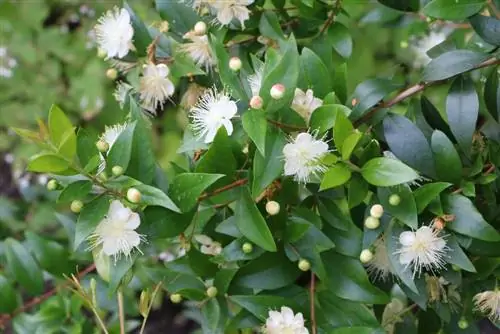- Author admin [email protected].
- Public 2023-12-17 03:39.
- Last modified 2025-01-24 12:45.
The crape myrtle, also known as crape myrtle or lagerstromia, is an ornamental plant with a strikingly beautiful summer flower. The color range of crepe myrtle is very remarkable. Here you will find out interesting information about this extraordinary plant as well as useful care tips and tips for proper wintering.
China's beautiful import
The crape myrtle has long been a common ornamental plant in subtropical regions. It was long known in this country as a cold house plant. However, it has now been shown that crepe myrtle can also be cultivated outdoors in milder regions here in Germany over the long term. By the way, the name crape myrtle refers to the petals. They are extremely narrow in the lower part, become wide towards the top and curl very strongly there. Their enemies include aphids and moisture.
Plant
The crepe myrtle was given the name Lagerströmie by its discoverer Magnus Lagerstroem. He discovered the plant in India and sent it to Sweden for identification. The crape myrtle is used as an ornamental tree, particularly in Asia, specifically in China, because its beauty lasts all year round. The deciduous tree belongs to the loosestrife family. Around 22 genera and around 450 different species are known. These are divided into three different classes. The first is the Lagerstroemia indica (Indian lilac), the ornamental Lagerstroemia speciosa (very large flowers) and the Lagerstroemia angustifolia (Bang-Lang) with a smooth and hard bark. The latter is used for the production of rifle butts.
Features
The crape myrtle blooms from the end of summer into autumn, i.e. from August to October. Depending on the culture, it can reach a size of over two meters and becomes more beautiful over the years. When in bloom, it boasts an enormous floral dress that lasts for weeks. The colors are warm and subtle. The orange, yellow or red coloring of the foliage occurs in autumn and in the winter months the bark appears blue-grey with smooth grain. The flowers of crape myrtle are small, cluster-like and terminal. The color spectrum ranges from purple, violet, red, numerous shades of pink to pure white. Each individual flower also has a minimal golden yellow bouquet of stamens in the center. The Lagerströmie produces capsule fruits that are usually dark, round and small. The capsule fruits contain some winged seeds. The fruits have a narcotic effect and are not edible.
Planting
The prettiest species of crape myrtle come from tropical regions. Around 30 hybrid species are adapted to our climate. Mature trees can even withstand enormous temperatures down to -15 °C. However, they achieve a more refined flowering at higher temperatures and in abundant sunlight. The location should be as sheltered from the wind and sunny as possible, as this particular plant loves the sun. You can achieve optimal growth results on particularly moist and neutral substrates. Furthermore, the soil should be well-drained, loose and deep. Avoid waterlogging. If you want to transplant or transplant your crepe myrtle, the correct technique depends on the local climatic conditions. In mild areas, the plant should ideally be transplanted or replanted after the leaves fall in autumn. Spring (frost-free), on the other hand, is the right season in regions where temperatures drop lower. If you keep your Lagerströmia in a pot, it must always be protected from frost. When planting, the roots are placed in an approx. 15 cm thick layer, which either consists of:
- pine needles
- half-rotted compost
- Flax shives
- or cocoa bean pods
and cover with soil at the end. In order to be able to fully insert the root ball into the soil, the planting pit must be at least three times the size of the root ball. If you want to plant several plants, please keep a distance of two to three meters. The crepe myrtle develops best when it stands alone.
Care
The optimal location for your crop is completely free of shade and particularly warm. A south-facing balcony or garden is perfect. During the summer, the crape myrtle is watered thoroughly every day. If the days are extremely hot, then only water the plant in the evening. During the flowering phase, fertilize your Lagerströmia once a month. Every year in February or March, cut the supporting shoots back quite a bit.
Tip:
Count the eyes on the branches. With four to six eyes, the branch has the optimal length of around 8 to 15 cm. Buds and root shoots that appear on the trunk should be removed because crape myrtle primarily grows like a bush. Pay attention to the side shoots if you want to keep the plant as a tree.
While cleaning your plant, remove the very small branches and twigs. This promotes air circulation and the flower stays nice and dense. In spring you can provide your plant with rose fertilizer. To do this, place the fertilizer into the soil as close to the trunk as possible. You can sow crepe myrtle, but propagation using half-woody cuttings or green cuttings is more recommended, as the chances of success are guaranteed. When you grow from seeds, the bushes often don't bloom for three to five years. While plants from cuttings bloom after about two years.
Diseases
The crape myrtle is particularly susceptible to powdery mildew due to cool, damp weather, especially in spring. The leaves turn whitish and lose their shape. However, you can then treat your plant with rose protection products or sulfur. If orange pimples have formed on the leaves of your plant in the summer, then it is an infestation of rust. In this case, you can help your plant with a broad-spectrum fungicide.
Wintering
The crepe myrtle is only partially winter-hardy and should be kept much cooler and darker in winter. The ideal temperature is around 0 to 5 °C room temperature. The light requirement is very low in winter because the crown is free of leaves from autumn onwards. Maintain consistent soil moisture for your potted plants. Specimens in the garden normally do not need any watering in winter.
Tip:
Shade the branches, for example by hanging spruce branches. This will prevent cracks in the bark that can occur during extreme temperature fluctuations. Cover the root area of your crape myrtle with a thick layer of autumn leaves, which has an insulating effect. At the beginning of spring, make it brighter again to promote the production of the shoots.
Frequently asked questions
Why is my potted plant losing its buds?
It may be that you have moved or twisted your crepe myrtle too much. The plant reacts very sensitively to this and can therefore lose its buds.
How exactly do I prune?
The crape myrtle is not cut back on the old wood. You only cut the annual and mature branches from the same year at the ends of the shoots. The crown, on the other hand, is cut back sharply once a year in late winter.
What you should know about crape myrtle in brief
Hardiness
Lagerstroemia indica and Lagerstroemia chekiangensis are among the varieties that can withstand temperatures as low as -18 °C in winter without freezing to death. Hardy crape myrtles are also sold commercially as Tuscan lilacs in various shades of color. The similarity to lilac cannot actually be denied, especially since the flower colors of the 15-40 cm long flower spikes are also similar to those of lilac. Since these varieties were given preferred names by Indian tribes, they are sometimes also referred to as Indian lilac. Older crepe myrtles are generally significantly more cold-resistant than young plants.
Selection of location
As an upright-growing shrub with a rounded crown, crepe myrtles want a particularly warm and sunny location. Not only does the magnificent shrub stand out extremely well in front of a white house wall, the wall also radiates additional warmth onto the plant. Gusts of wind are not tolerated, so you should choose a place that is as sheltered as possible.
Tips for caring for hardy crape myrtle
- Especially when kept in a pot, the top layer of soil should always be slightly dry before watering again, because crape myrtle doesn't get waterlogged at all.
- The substrate must not contain lime, as it is not tolerated.
- Commercial garden soil meets the requirements of crape myrtle.
- Liquid fertilizer every 4 weeks provides all the necessary nutrients.
- Crepe myrtle should not be transplanted often.
- Regular vigorous thinning promotes growth.
Overwintering crape myrtle
Since the winter hardiness can vary greatly between different crepe myrtle species, you should definitely pay attention to frost resistance when purchasing. Only the predestined varieties are suitable for outdoor overwintering. Since even the winter-hardy crepe myrtles only have limited frost hardiness, extremely rough areas pose a problem. A cold greenhouse for overwintering would be a good solution there. In milder locations, such as wine-growing regions, winter frost protection made of leaf mulch and branches from conifers should not be missing, despite certified frost hardiness.
Lagerstroemia, which is becoming increasingly popular with us, transforms the garden into a holiday paradise from summer to autumn. Hardy crepe myrtles can even be left outside during the cold months.






